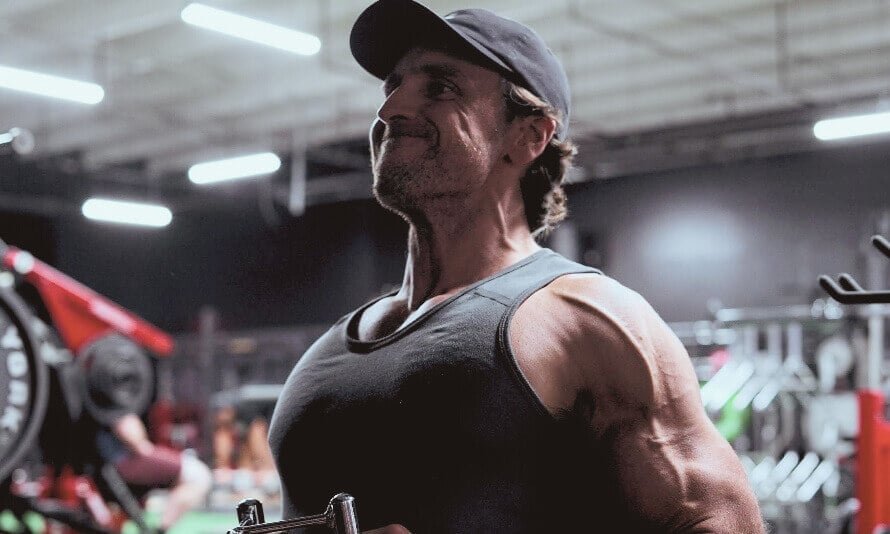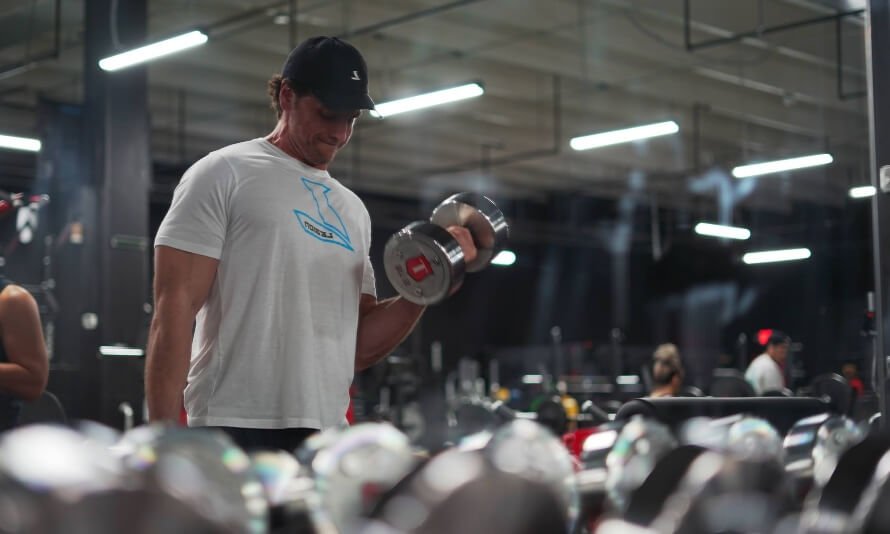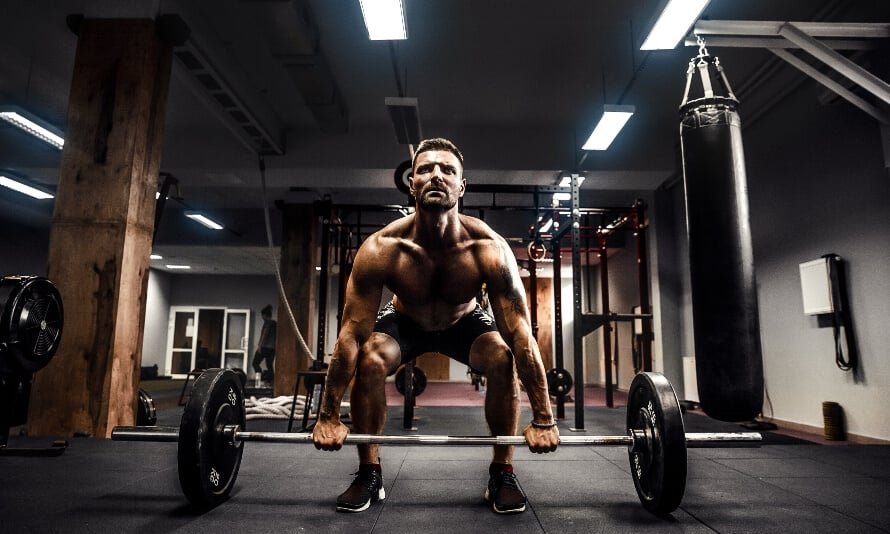[ad_1]
Fact Checked
Evidence Based
Research shows that broad shoulders on men are a sign of strength and dominance.
Studies also show that wide shoulders are one of the most important traits women look for in a mate.
These facts likely explain why so many men relentlessly seek out how to get broader shoulders.
So, why aren’t all guys sporting a set of “3D delts?”
The answer is simple: most make diet and training mistakes that hinder their shoulder development.
In this article, you’ll learn how to sidestep these common errors.
You’ll also discover what broad shoulders are (technically), why they’re advantageous, how to measure shoulder width and circumference correctly, how to get broader shoulders, including the best diet tips and exercises for broad shoulders, and more.
What Are “Broad Shoulders?”
When most people describe a person as having “broad shoulders,” they mean their shoulders are considerably wider than the rest of their torso, particularly their waist.
Here are some pictures of celebrities with broad shoulders that illustrate this well:
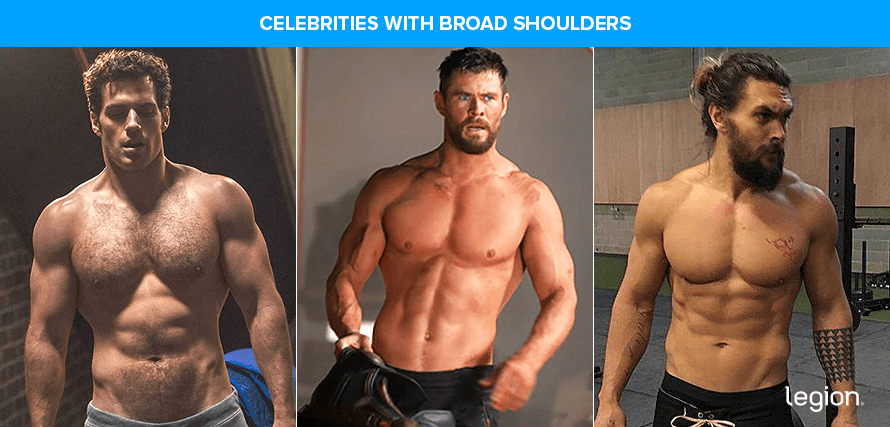
Why Do Men Want Broad Shoulders?
Aside from being an integral part of a balanced upper body, the main reason men want broad shoulders is because . . . well . . . women want men with broad shoulders.
Research shows that people typically consider men with wide shoulders to be more physically attractive than men with narrower shoulders, especially when they also have a slim waist.
Specifically, studies on attractiveness show that 1.618 is the ideal shoulder-to-waist ratio for men. That means if you multiply your waist width by 1.618, you’ll arrive at your ideal shoulder width measurement for attracting the fair sex.
If you’ve already reached for the measuring tape and aren’t thrilled with the results, remember that this ideal ratio is based on the visual width of your shoulder and waist, not their circumference.
That is, if you stand in front of a mirror with your hands at your sides and have someone place a measuring stick in front of your shoulders and waist, you’d want the former measurement to be 1.618 times the latter.
For example, if you have a waist that’s 12 inches wide, you’d want your shoulders to be about 19 inches across—a target well within reach if you have a decent amount of muscle mass and a low body fat percentage.
How to Measure Shoulder Width and Circumference
To compare your current shoulder size to your “ideal” shoulder size, you have to know how to measure shoulder width and circumference.
Here’s how:
How to Measure Shoulder Width
Shoulder width—also known as biacromial breadth or biacromial diameter—is the distance between the two outermost bony points located on the back of your shoulders.
Since your bone structure determines your biacromial breadth, you can’t alter it through diet or exercise, so it tells you nothing about how you’re progressing in the gym.
That’s why, for our purposes, it’s better to measure shoulder width like this:
Stand upright with your arms at your sides and have a friend measure the distance between the two outermost points of your shoulder muscles using a tape measure.
Using this method to track changes in shoulder width over time will give you the best indication of whether you’re adding muscle, and thus width, to your shoulders.
How to Measure Shoulder Circumference
Shoulder circumference is the distance around the widest part of your shoulders, taking into account the muscles in your upper back (traps and rhomboids), chest, and shoulders (front, side, and rear delts), as well as any stored fat in this area.
You can manipulate shoulder circumference through diet and exercise—you can gain muscle or fat to increase your shoulder circumference or lose muscle or fat to decrease your shoulder circumference. Obviously, you want more muscle and less fat so that you also have defined muscles.
To measure your shoulder circumference, stand upright, relax your upper body, allowing your arms to hang at your sides, then have a friend wrap a tape measure around your body at shoulder height where your shoulders are widest. This is usually around the top of your armpits.
Note this measurement and track it every few weeks. Provided this measurement increases over time, you’re likely building bigger shoulders.
That said, you shouldn’t get too wrapped up in this measurement since the size of your chest and upper back and your body fat percentage can also influence it.
In other words, you could increase your shoulder circumference without gaining shoulder muscle by building bigger pecs and lats or decrease your shoulder circumference by losing fat on your chest and back.
Nevertheless, it’s still a valuable metric to monitor your progress.
How to Get Broader Shoulders
1. Diet to build muscle.
Exactly how this looks depends on your previous strength training experience:
- New weightlifters: When new to strength training, your body is hyper-responsive to its effects, allowing you to build muscle even when you’re in a calorie deficit. Thus, if you’re a beginner weightlifter looking to build broader shoulders while losing fat, aim to eat 20-to-25% fewer calories than you burn every day. Or, if you’re already lean but still want to grow your shoulders, aim to eat approximately the same number of calories as you burn daily.
- Experienced weightlifters: After 6 months or more of consistent training, you must eat more calories than you burn to build muscle effectively. Aim for 110% of your total daily energy expenditure to maximize muscle growth while minimizing fat gain.
In both scenarios, you also need to eat the right amount of protein, carbs, and fat. Here are some good guidelines:
- Eat 1 gram of protein per pound of body weight per day.
- Get 20-to-30% of daily calories from fat.
- Get the remainder of your calories from carbs.
If you’d like more specific information about how to eat to build wider shoulders, take the Legion Diet Quiz. In less than a minute, you’ll know how many calories, how much of each macronutrient, and which foods you should eat to reach your goals. Click here to check it out.
2. Do the right exercises for broad shoulders.
To build broad shoulders, you have to do shoulder exercises that develop all three heads of the deltoids (shoulder muscles). Here’s what they look like and how to train each:
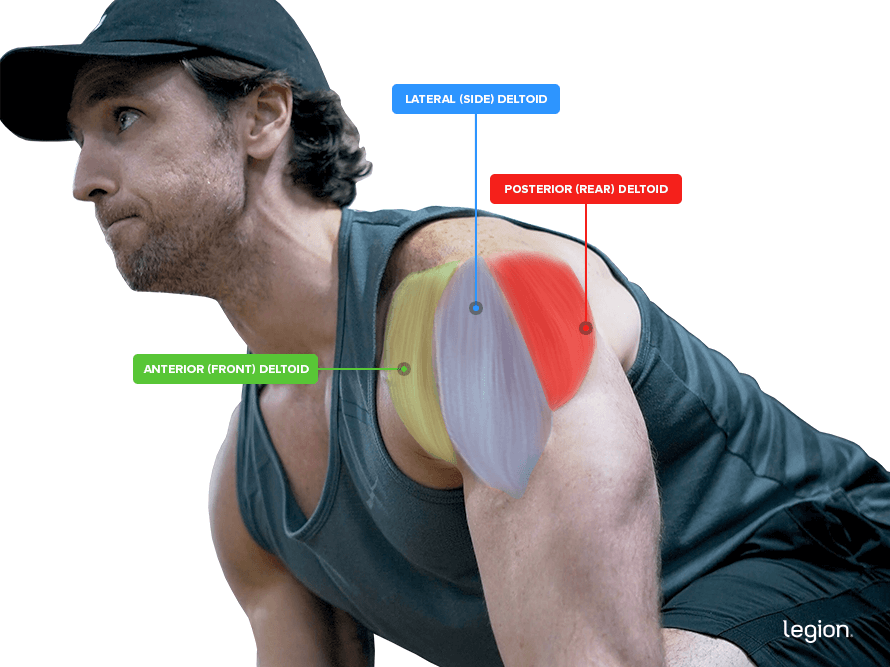
- Anterior deltoid: Building the “front delts” mostly comes down to getting stronger at compound pressing exercises, such as the seated and standing overhead press, flat and incline bench press, and flat and incline dumbbell press. If you can’t perform these exercises, the dumbbell front raise is a viable workaround.
- Lateral deltoid: Exercises that involve raising your arms to the sides to lift the weight are typically best for training the “side delts.” The dumbbell side lateral raise, cable side lateral raise, and upright row are all excellent options.
- Posterior deltoid: To train your “rear delts,” get as strong as possible at compound “pulling” exercises, such as the pull-up, lat pulldown and barbell, dumbbell, and T-bar row.
For a strength training program that includes all the best exercises for broad shoulders, check out this article:
Hypertrophy Training: Best Workout Program for Hypertrophy
3. Once you’ve gained shoulder muscle, get leaner.
You can gain all the shoulder muscle you want, but if your body fat percentage is too high and your waist is too wide, you’ll never get close to the 1.618 ratio.
And that means your shoulders will never look as broad as you’d like.
That’s why it’s vital to switch your attention to getting lean once you’re happy with your shoulder size and width.
The key to this is following a fat-loss diet that has you eating fewer calories than you burn daily.
For guidance on creating an effective weight loss diet, check out this article:
The Absolute Best Diet for Weight Loss
+ Scientific References
- Braun, Margaret F., and Angela Bryan. “Female Waist-To-Hip and Male Waist-To-Shoulder Ratios as Determinants of Romantic Partner Desirability.” Journal of Social and Personal Relationships, vol. 23, no. 5, Oct. 2006, pp. 805–819, https://doi.org/10.1177/0265407506068264.
- Singh , Devendra. “APA PsycNet.” Psycnet.apa.org, 1995, psycnet.apa.org/record/1996-14246-001. Accessed 28 Nov. 2023.
- Horvath, T. “Physical Attractiveness: The Influence of Selected Torso Parameters.” Archives of Sexual Behavior, vol. 10, no. 1, Feb. 1981, pp. 21–24, https://doi.org/10.1007/bf01542671. Accessed 6 Mar. 2020.
You May Also Like
Our Most Popular Evidence-Based Articles
You don’t need supplements to build muscle, lose fat, and get healthy. But the right ones can help.
Take our 60-second quiz now to learn which supplements can help you achieve your fitness goals faster.
Sending…
Your free stuff is on the way!
Follow the Diet Plan that Helped Nikita Lose 15 Pounds in 3 Months
“I never thought getting in shape would be this simple! Everything just WORKS when you follow this plan.” And if he can do it, why not you?

Wait!
Want a Free Custom Meal Planning Tool?
Quickly calculate your calories, macros, and micros for losing fat, building muscle, and staying healthy.
Our “No Return Necessary”
Money-Back Guarantee
If you don’t like something of ours, guess what happens next?
No, we don’t request you deliver it to a PO box in the Gobi Desert by carrier pigeon. Nor do we ask you to fill a cursed inkwell with orc’s blood and demon saliva and then use it to complete reams of return forms written in ancient Cyrillic script.
We just . . . wait for it . . . give you your money back. Holy moo cows. And that means you can say “yes” now and decide later.
Free Worldwide Shipping & Returns
Many companies use shipping and handling fees to increase their profit margins, but here at Legion, we hate profits, so our shipping is free!
Okay, so we do dig on profits, but we also go in for happy customers, and free shipping works like gangbusters. So, if you live in the United States, your order ships free regardless of order size, if you live in the UK or Canada, your order ships free when it’s over $99, and if you live elsewhere, your order ships free when it’s over $199.
Also, if you don’t absolutely love our stuff for whatever reason, we don’t request you deliver it to a PO box in the Gobi Desert by carrier pigeon.
We just . . . wait for it . . . give you your money back. No returns. No forms. No nonsense. Holy moo cows.
That means you can say “yes” now and decide later. You really have nothing to lose.
Free Worldwide Shipping & Returns
Many companies use shipping and handling fees to increase their profit margins, but here at Legion, we hate profits, so our shipping is free!
Okay, so we do dig on profits, but we also go in for happy customers, and free shipping works like gangbusters. So, if you live in the UK or Canada, your order ships free when it’s over $99.
Why the restriction on international orders? Unfortunately, shipping abroad is very expensive, and if we didn’t require a minimum order size, we’d lose a lot of money. But! We’re also hustling to improve our international logistics and will be passing our savings along to our international customers.
Also, if you don’t absolutely love our stuff for whatever reason, we don’t request you deliver it to a PO box in the Gobi Desert by carrier pigeon.
We just . . . wait for it . . . give you your money back. No returns. No forms. No nonsense. Holy moo cows.
That means you can say “yes” now and decide later. You really have nothing to lose.
Free Worldwide Shipping & Returns
Many companies use shipping and handling fees to increase their profit margins, but here at Legion, we hate profits, so our shipping is free!
Okay, so we do dig on profits, but we also go in for happy customers, and free shipping works like gangbusters. So, if you’re outside the USA, your order ships free when it’s over $199.
Why the restriction on international orders? Unfortunately, shipping abroad is very expensive, and if we didn’t require a minimum order size, we’d lose a lot of money. But! We’re also hustling to improve our international logistics and will be passing our savings along to our international customers.
Also, if you don’t absolutely love our stuff for whatever reason, we don’t request you deliver it to a PO box in the Gobi Desert by carrier pigeon.
We just . . . wait for it . . . give you your money back. No returns. No forms. No nonsense. Holy moo cows.
That means you can say “yes” now and decide later. You really have nothing to lose.
Clinically Effective Ingredients & Doses
Many ingredients in supplements don’t have any scientifically validated benefits, and many ingredients that do are often underdosed to the point of irrelevance.
That’s why we only use the choice ingredients and precise doses shown to be effective in peer-reviewed scientific studies.
Clinically Effective Doses
You need more than great ingredients to make great products—you also need proper doses. That’s why we use the precise doses of ingredients shown to be effective in peer-reviewed scientific studies.
Natural Ingredients
“Natural” doesn’t always mean “better,” but in many cases, natural ingredients are superior to artificial ones for various reasons, including purity, safety, and efficacy.
That’s why all of our ingredients in all of our products come from plant and animal sources, including sweeteners, colors, and flavors.
Made in USA with Globally Sourced Ingredients
If you want to ensure the supplements you’re swallowing every day are safe and effective, you want products produced in the USA.
That’s why all of our supplements are made in America in NSF-certified and FDA-inspected facilities that operate in accordance with the Current Good Manufacturing Practice (cGMP) regulations.
Lab Tested
Did you know that supplements can contain dangerously high levels of toxins like lead, arsenic, and cadmium?
That’s why we test every ingredient of every supplement we produce for heavy metals, microbes, allergens, and other contaminants and ensure they meet the strict purity standards set by the FDA.
Naturally Sweetened & Flavored
While artificial sweeteners may not be as dangerous as some people claim, studies suggest that regular consumption of these chemicals may indeed be harmful to our health.
That’s why all of our supplements are naturally sweetened and flavored and contain no artificial food dyes, fillers, or other unnecessary junk.
Science-Backed Ingredients
Many ingredients in supplements don’t have any scientifically validated benefits. That’s why we only use choice ingredients shown to be effective in peer-reviewed scientific studies.
No Chemical Junk
“Natural” doesn’t always mean “better,” but in many cases, natural ingredients are superior to artificial ones for various reasons, including purity, safety, and efficacy.
That’s why all of our ingredients in all of our products come from plant and animal sources, including sweeteners, colors, and flavors.


Split your entire online purchase into 4 interest-free payments, over 6 weeks with no impact to your credit.

25%
today
25%
2 weeks
25%
4 weeks
25%
6 weeks

Shop and add items to your cart as normal!

Choose Sezzle at Checkout! You’ll be redirected to Sezzle to Sign Up or Log In
to complete your order.

Your order will be shipped out right away* and your payments will be split up
over 6 weeks.
*shipping times subject to merchant shipping policy
Shop directory. Reschedule payments. Plus more!
Waiver and Release of Liability
In consideration of the services and/or products offered by Legion Athletics, Inc. (“Legion”) including, but not limited to, nutrition plans, exercise routines and coaching, and in addition to the payment of any fee or charge:
I knowingly and voluntarily enter into this waiver and release of liability and hereby waive any and all rights, claims or causes of action of any kind whatsoever arising out of my use of Legion’s services and/or products, and I hereby release and hold harmless Legion and its consultants, officers, contractors, agents, owners and employees from any and all responsibility, liability, cost and expenses, including for injuries, damages or disorders (physical, metabolic, or otherwise), resulting from my use of Legion’s services and/or products.
I understand that fitness activities including, but not limited to, strength, flexibility, and cardiovascular exercise, with or without the use of equipment, are potentially hazardous activities that involve a risk of injury and even death, and I am voluntarily participating in these activities and using equipment and machinery with knowledge of the risks involved. I hereby agree to assume and accept any and all risks of injury or death related to said fitness activities.
I understand Legion’s services and products are not meant to treat or manage any health conditions or circumstances, and I acknowledge that Legion has recommended I obtain a healthcare provider’s approval for my use of Legion’s services and/or products, through regular physical examination(s) and/or consultation. I acknowledge that I have obtained my healthcare provider’s approval or have decided to use Legion’s services and/or products without such approval and hereby assume all responsibility for my use of said services and/or products.
I understand that results from using Legion’s products and/or services are not guaranteed, and I agree to not hold Legion liable for any outcomes or lack thereof.
OUT OF STOCK
Security Check
Please click the checkbox below. We apologize for the inconvenience.
If you don’t absolutely love this product, just let us know, and we’ll give you a full refund on the spot. No forms or return necessary.
Analyzed for purity and potency in a state-of-the-art ISO 17025 accredited lab by Labdoor™, the gold standard of third-party lab testing.
Analyzed for purity and potency in a state-of-the-art ISO 17025 accredited lab, the gold standard of third-party lab testing.
This product doesn’t just “contain natural ingredients”—every ingredient is naturally sourced from plants and animals. This product contains no artificial or synthetic sweeteners or flavors of any kind.
Fact Checked
Our scientific review board of nutritionists, dietitians, molecular biologists, doctors, and other accredited experts is responsible for reviewing every article, podcast, and video we produce to ensure they’re evidence based, accurate, trustworthy, and current.
Thanks to their connections, credentials, and academic experience, this team of MDs, PhDs, and other professionals has access to a wealth of research published in the largest and most prestigious journals in the world.
This allows them to not only review individual studies but also analyze the overall weight of the evidence on any and all topics related to diet, exercise, supplementation, and more.
If you feel that any of our content is inaccurate, misleading, out-of-date, or anything less than factual, please let us know in the comments section of the article in question.
Evidence Based
We follow a detailed, rigorous, multi-step process to create content that meets the highest standards of clarity, practicality, and scientific integrity.
First, our research associates provide our editorial team with accurate, up-to-date, proven scientific evidence.
Then, our editorial team uses this research to draft articles and outlines for podcasts and videos.
Finally, our scientific review board reviews the content to ensure all key information and claims are backed by high-quality scientific research and explained simply and precisely.
If you feel that any of our content is inaccurate, misleading, out-of-date, or anything less than factual, please let us know in the comments section of the article in question.
[ad_2]
Source link
